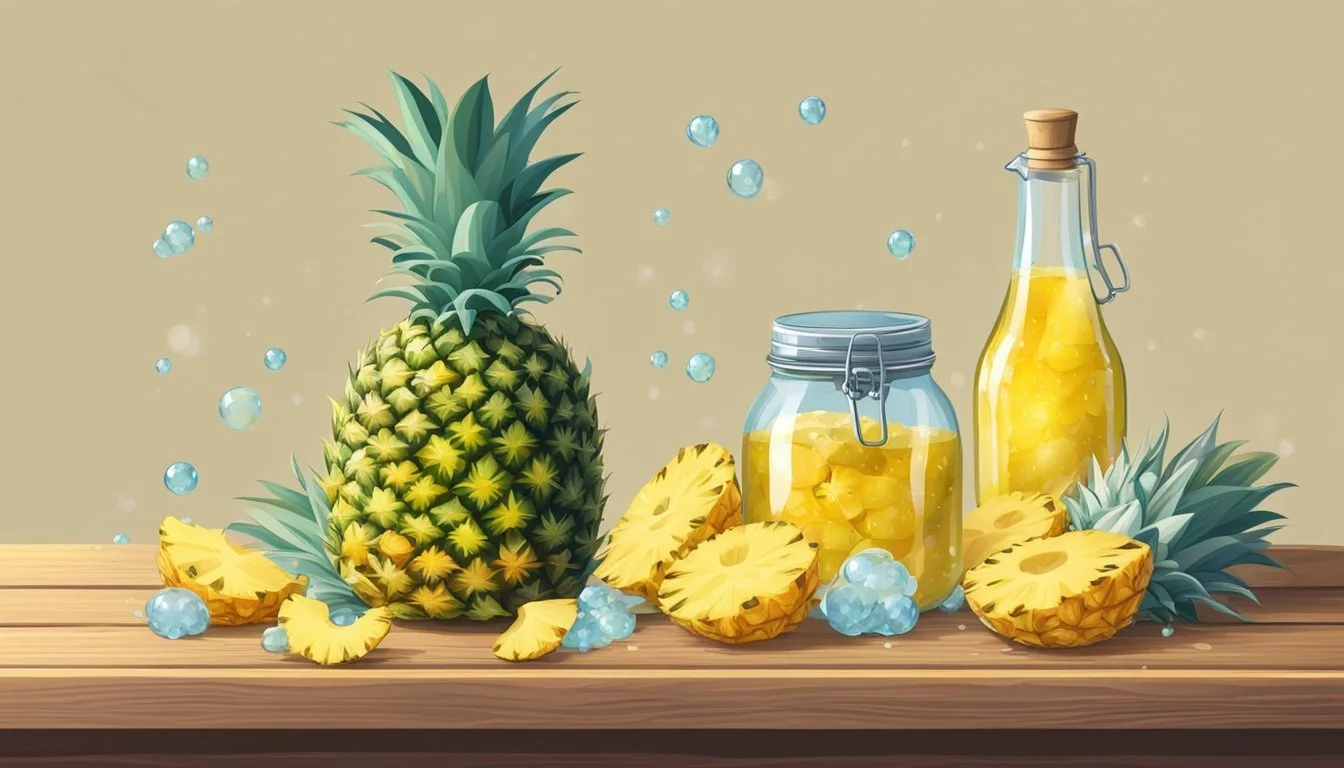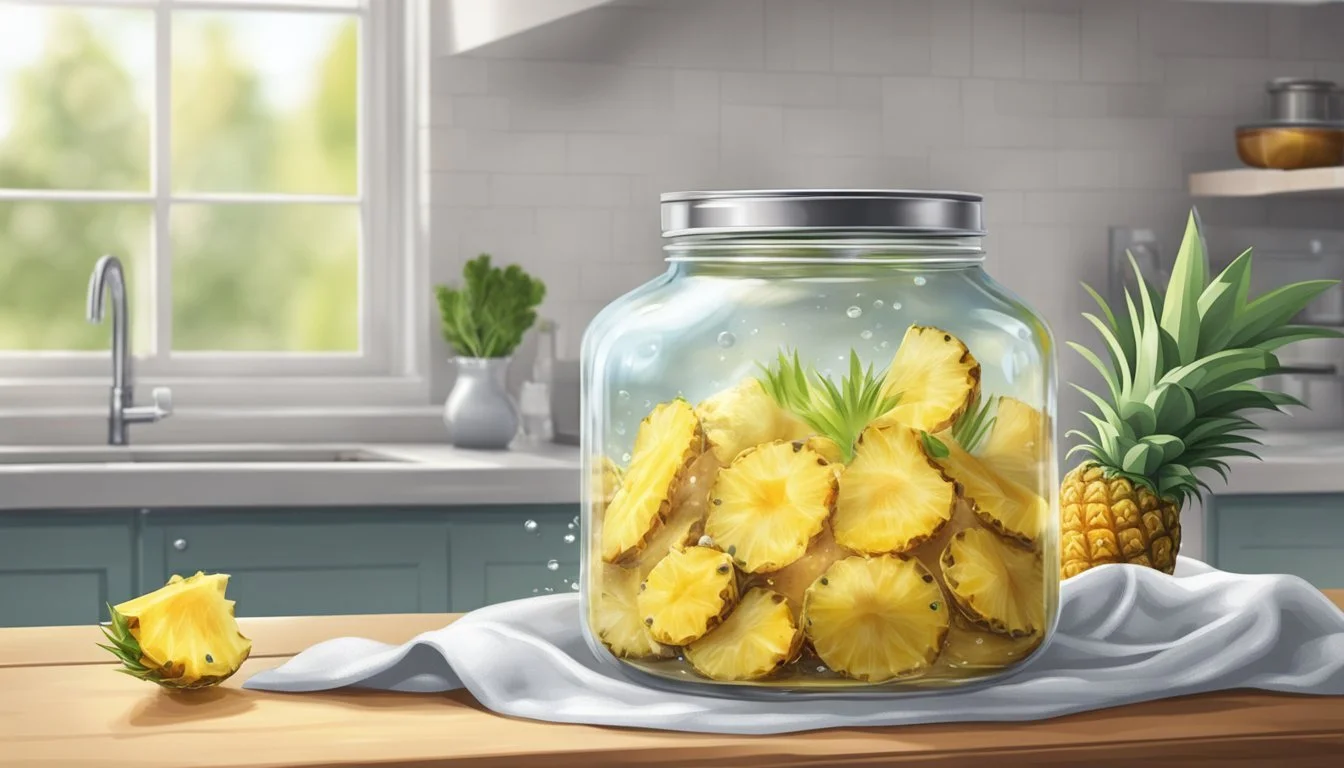Pineapple Peel Tepache
An Insight into the Refreshing Probiotic Drink
Tepache is a traditional Mexican fermented beverage that embodies the resourcefulness and vibrant flavors of the region’s culinary culture. Made from the peels of pineapple, this drink is both sustainable and packed with taste. Utilizing parts of the fruit that would typically be discarded, tepache is a testament to the idea that nothing need go to waste. The fermentation process imbues the beverage with a uniquely tangy flavor profile, creating a refreshing and slightly effervescent drink ideal for warm days.
The creation of tepache begins with the pineapple peel, which is steeped in water with additional ingredients such as piloncillo–a type of unrefined cane sugar–and spices like cinnamon and clove. These components complement the tartness of the pineapple and add depth to the final product. As fermentation occurs, usually over a period of three to five days at room temperature, the sugars are converted into alcohol, giving tepache its characteristic lift and subtle sweetness.
This fermented drink is not only rooted in tradition but also gaining popularity in the modern culinary scene. Its low alcohol content makes it an enticing option for those seeking a milder alternative to beer or cider. With its simple preparation and distinctive flavor, tepache offers enthusiasts an enjoyable foray into the world of fermented drinks while honoring its Mexican heritage.
The History and Origin of Tepache
Tepache is a traditional Mexican fermented beverage with a rich heritage that dates back to pre-Hispanic Mexico. The roots of Tepache stretch deep into the history of the Aztec civilization, where it was originally crafted. The indigenous Nahuatl people, known for their significant contributions to Mexican culture, are credited with the invention of this refreshing drink.
Initially, Tepache was made from corn, but over time, the method evolved, and now it primarily utilizes the peels and rind of pineapples. The process was simple and practical: fermenting the natural sugars found in these pineapple parts to create a lightly effervescent and sweet beverage. It was typically sweetened with piloncillo (unrefined cane sugar) and seasoned with spices such as powdered cinnamon.
Historically, Tepache was more than a mere drink; it held a sacred place in Aztec traditions, often linked with ceremonial practices and rituals. As a testament to its cultural significance, even centuries after the fall of the Aztec empire, Tepache remains a beloved drink in modern Mexico. This legacy is evident in the way Tepache is still enjoyed and sold by street vendors, often poured from large barrels that accentuate its fermentation process.
Tepache's alcohol content is typically low, but variations exist, with some choosing to spike the drink with a small amount of beer to increase its potency. This feature underlines Tepache's flexible nature—embracing evolution while honoring its historical roots.
Basics of Tepache Brewing
Tepache brewing harnesses the natural fermentation process to transform simple ingredients into a mildly alcoholic, refreshing beverage with roots in Mexican culinary tradition.
Ingredients for Tepache
The key components in making Tepache are quite straightforward, revolving mainly around pineapple, sugar, and spices. Here is a concise list of what you'll need:
Pineapple: To make Tepache, the peel is essential, often leaving a bit of flesh attached for flavor. The core can be used but is typically excluded due to potential bitterness.
Water: Clean, preferably non-chlorinated water is used to create the brew.
Sugar: Traditionally, Piloncillo, an unrefined Mexican cane sugar, is used for its rich flavor, but brown sugar is a suitable substitute.
Spices: A combination of cinnamon and clove adds depth and complexity to the flavor profile.
Optional:
For variation or to suit personal taste preferences, ingredients like ginger or additional fruits can be incorporated.
Equipment Required
Tepache brewing doesn't require complex equipment, but there are a few essentials:
Fermenting Vessel: A large jar or a food-safe container can serve as a suitable vessel for fermentation.
Strainer: To separate solids from the liquid after fermentation is complete.
Cloth and Secure Band: A cloth cover allows airflow while keeping contaminants out; it can be secured with a rubber band or string.
Spoon: A large spoon is helpful for stirring the mixture.
The fermentation process is initiated by the natural yeast present on the pineapple skin. This is similar to how kombucha relies on a SCOBY to ferment. The Tepache brew should be left undisturbed and away from sunlight, as it ferments at room temperature, usually over a period of 3-4 days. During this time, the naturally occurring yeast consumes the sugar, producing a light alcohol content and carbonation. Regular stirring is recommended to ensure even fermentation and integration of flavors. After fermentation, straining the mixture yields a clear, aromatic brew. The result is a homemade Tepache rich in taste and heritage, with a fraction of the alcohol content of traditional beer.
The Fermentation Dynamics
In creating Tepache, a traditional Mexican fermented beverage, the transformation of pineapple peel's sugars into alcohol and carbon dioxide is a careful interplay of microbiological activity and temperature management. The fermentation process introduces not only effervescence but also beneficial probiotic attributes.
Understanding Fermentation
Fermentation is a metabolic process that converts sugar to acids, gases, and alcohol. In the case of Tepache, yeasts and bacteria present on the pineapple skin act as natural fermenting agents. As they consume the sugars in the presence of water, they release carbon dioxide, which contributes to the characteristic carbonation of the drink, and a modest level of alcohol content. The process also promotes the growth of probiotics, beneficial bacteria that contribute to gut health.
Yeast & Bacteria: Initiators of fermentation, contributing to Tepache's unique taste.
Carbonation: A natural outcome of fermentation, providing fizz to the beverage.
Alcohol Content: Relatively low (<1%) as fermentation is brief.
Probiotics: Resulting from bacterial activity, improving the beverage's health profile.
Temperature Control
The rate and success of fermentation in Tepache are heavily influenced by temperature. The ideal range to encourage optimal yeast and bacterial activity is typically between 20°C and 25°C (68°F and 77°F). Too high a temperature accelerates fermentation excessively, risking an overly sour taste or spoilage. Conversely, temperatures that are too low can slow or stall the process entirely.
Ideal Temperature Range: 20°C - 25°C / 68°F - 77°F
Too High: Could lead to spoilage.
Too Low: Could halt fermentation.
Fermentation Time plays a critical role and typically ranges from 24 hours to 5 days, depending on ambient temperatures and desired level of fermentation. Regular checks are necessary to gauge the progress of fermentation and to prevent the development of off flavors or undesirable levels of alcohol.
The Recipe
Creating pineapple tepache involves a series of straightforward steps, transforming simple ingredients into a fizzy, tangy beverage that's both refreshing and packed with probiotics. This traditional Mexican drink, commonly referred to as pineapple beer, boasts a unique flavor profile and a very low alcohol content.
Preparation Steps
First, gather the primary ingredients: the peels and core of one pineapple, about one cup of piloncillo (unrefined cane sugar) or brown sugar, one cinnamon stick, and a few cloves. Ensure the pineapple is ripe and the peels contain some flesh for added flavor. This sweet blend of flavors is the starting point of your tepache.
Rinse the pineapple thoroughly to remove any external impurities.
Cut and discard the crown and base of the pineapple; slice the peel into chunks, including some flesh.
Combine the pineapple peels, piloncillo (or brown sugar), cinnamon stick, and cloves into a large, non-reactive container, like a glass jar.
Fermentation Steps
To the mix, add around half a gallon of non-chlorinated water; this ensures that the chlorine doesn't inhibit the fermentation process where the natural yeast on the pineapple peels will work to ferment the beverage.
Cover the container with a cheesecloth or a clean towel. This will let the concoction breathe and allow wild yeasts from the environment to contribute to the fermentation.
Place the vessel in a warm spot out of direct sunlight to ferment for approximately 2 to 3 days, depending on the desired level of fermentation.
Second Fermentation
For a naturally carbonated, sweeter, and fizzier pineapple tepache, a second fermentation process is recommended.
After the primary fermentation, strain the liquid to remove the solids and then transfer the liquid into bottles that can be sealed.
Leave about an inch of headspace at the top to avoid excessive pressure build-up.
Seal the bottles and place them in a warm area to ferment for an additional 12 to 24 hours before transferring them to the refrigerator to slow down the fermentation.
Serve the pineapple tepache chilled, and enjoy the unique blend of sweetness, tang, and slight effervescence.
Health Benefits of Tepache
Tepache, a traditional Mexican beverage made from the fermentation of pineapple peels, is not just a refreshing drink but also a source of various health benefits. Brewed with the rinds of pineapples, a fruit known for its high vitamin content, Tepache boasts a nutritional profile that supports overall well-being.
Probiotics: The fermentation process of Tepache enhances the growth of beneficial bacteria or probiotics. These play a crucial role in maintaining a healthy intestinal flora, which is essential for good digestion and overall gut health.
Vitamin C and Antioxidants: Being made from pineapple, Tepache naturally contains vitamin C, an antioxidant that helps in protecting the body against free radicals. Antioxidants also contribute to a robust immune system and promote skin health.
Bromelain: Pineapples are a rich source of bromelain, an enzyme that has been studied for its anti-inflammatory properties and its ability to aid in the digestion of proteins.
Minerals and Vitamins: Tepache, while being a low-calorie drink, is modest in minerals such as manganese and calcium, and it provides a spectrum of other vitamins essential for various bodily functions.
Diuretic Properties: To a certain extent, Tepache may exhibit diuretic properties, which help in flushing out toxins from the body and maintaining kidney health.
It is important to note that while Tepache contains these healthful components, moderation is key, as it can also contain sugar depending on the recipe used. Homemade versions allow for adjusting the sweetness level to suit individual dietary needs.
Tepache Variations and Mixology
Tepache, a traditional Mexican fermented beverage, has evolved into a versatile drink with numerous variations. These adaptations showcase the ability to infuse different flavors from fruits and spices and to incorporate it into modern mixology.
Fruit and Spice Variations
Tepache traditionally begins with the peel of an organic pineapple, leveraging its natural yeast for fermentation. Chefs and home brewers alike experiment with additional fruits like mango, lemon, and orange to introduce new dimensions of flavor. The sweetness can be adjusted with natural sweeteners like panela, a raw form of cane sugar that adds a rich, caramel-like essence.
Orange and Mango Tepache: Adds a citrusy zing and tropical sweetness.
Lemon and Pepper Tepache: Offers a bright tartness with a subtle spicy kick.
Tepache Cocktails
Integrating Tepache into cocktails opens a world of mixology potential. Its mild effervescence and sweet-tart profile make it an excellent pairing for spirits such as rum and tequila, creating refreshing drinks suitable for any season.
Tepache Rum Punch: Combines Tepache with rum and fruit juice for a festive concoction.
Tequila Tepache Twist: A mix of Tepache and tequila, garnished with a lemon or orange slice for an elevated tropical beverage.
In these cocktails, Tepache acts as both a flavor component and as a unique effervescent agent, giving a lift to traditional cocktail recipes. Whether enjoyed in its traditional form or as a part of a complex cocktail, Tepache remains a versatile and flavorful addition to the beverage world.
Food Pairings and Serving Suggestions
Pineapple peel tepache pairs well with a variety of foods and serves as an excellent complement to many traditional dishes. Its slightly sweet, tangy flavor and effervescent nature make it particularly refreshing when served chilled on hot summer days. Tepache's cider-like quality allows it to sit comfortably alongside savory snacks (What wine goes well with savory snacks?) and meals.
One can pair this fermented beverage with Mexican street foods such as tacos and tostadas for an authentic experience. The tanginess of tepache can cut through the richness of meats like carnitas or al pastor. It also complements lighter vegetarian options, like tacos filled with sauteed vegetables or black beans. The subtle sweetness of the drink enhances the flavors of spicy salsas and fresh cilantro.
For a tropical twist, include tepache in a fruit salad containing banana, mango, and papaya. The natural fermentation of tepache will harmonize with the sweetness of the fruits, providing a complex flavor profile.
In a table setting, tepache can be presented as a non-alcoholic alternative to alcoholic ciders or sodas, making it a suitable choice for all ages and preferences. Additionally, for those looking to explore cultural drinks, tepache can be introduced alongside maize-based beverages like atole — a traditional warm corn drink — offering a contrast between the cold, bubbly tepache and the smooth, hot texture of the maize drink.
Here's a quick guide to serving tepache:
Serve tepache well-chilled.
Offer it in clear glasses to showcase its natural amber hue.
Garnish with a slice of pineapple or a cinnamon stick for added visual appeal.
When introducing tepache to guests or at gatherings, highlight its origins and homemade nature to spark conversations and provide a memorable tasting experience.
Troubleshooting Common Issues
When making Tepache, one may encounter several common issues that can affect the quality of the beverage. Here's how to identify and remedy them:
Container and Covering:
Issue: Insufficient oxygen during the first fermentation phase.
Solution: Ensure the fermentation vessel is covered with a cheesecloth or a clean dusting cloth to allow airflow, and secure it with a rubber band.
White Foam Development:
Issue: Presence of white foam on top of the fermenting liquid.
Solution: This foam is typically a sign of healthy fermentation. Skim it off if it becomes excessive or develops an off odor.
Odor and Taste:
Concern: Developing a yeasty or sourdough-like smell or taste.
Solution: Yeasty aroma is normal to some extent. If the Tepache begins to smell overly sour or unpleasant, it may be over-fermented. To prevent this, taste test the beverage regularly and place it in the refrigerator to slow fermentation when the desired flavor is achieved.
Fermentation Process:
Issue: Lack of effervescence or signs of fermentation.
Solution: Ensure the ambient temperature is within the optimal range (typically between 70-75°F). If necessary, add a bit more sugar to reactivate the fermentation process.
Troubleshooting Summary:
Problem Signs Action to Take Insufficient Oxygen Slow fermentation Use breathable covering like cheesecloth White Foam Excess foam on top Skim off foam regularly Odd Odor/Taste Overly sour or unpleasant smell Refrigerate to stop fermentation Lack of Fermentation No bubbles or effervescence Maintain optimal temperature or add sugar
By monitoring these common issues and taking the appropriate actions, one should be able to produce a delightful batch of Tepache.
Frequently Asked Questions
What container should be used to ferment Pineapple Peel Tepache?
For fermenting Pineapple Peel Tepache, one can use either a glass jar or a pitcher. A non-reactive vessel such as glass helps to ensure that the flavor remains unaltered and the fermentation process is not affected by any interaction with the container's material.
Is Pineapple Peel Tepache alcoholic?
Pineapple Peel Tepache is a naturally fermented beverage, and as such, it typically contains a very low level of alcohol, usually below 2%. It is commonly enjoyed as a non-alcoholic drink due to its minimal alcohol content.
Can my Tepache turn into vinegar?
If Tepache is left to ferment for an extended period, the alcohol can convert to vinegar, creating a more sour taste. To avoid this, one should monitor the fermentation process and taste it periodically to ensure it is stopped at the preferred level of sweetness and tanginess.
How to cover the fermenting Tepache?
While fermenting, the container should be covered with a kitchen towel or clean cloth, secured with a rubber band or string. This allows air to flow in and out, which is necessary for the fermentation process, while keeping out contaminants.
What kind of sugar is best for Pineapple Peel Tepache?
Both unrefined cane sugar and white sugar can be used for Pineapple Peel Tepache. Unrefined cane sugar, such as piloncillo or panela, is traditional and can lend a richer flavor profile to the drink.
Are there any nutrition facts available for Tepache?
The precise nutrition facts for homemade Tepache can vary, but it typically contains some beneficial bacteria due to the fermentation, as well as trace amounts of vitamins and minerals from the pineapple.
Can other spices be added to a Pineapple Tepache recipe?
Yes, spices such as cinnamon, cloves, and star anise are often added to enhance the flavor. These should be added during the initial mixing stage before fermentation begins.
Where can one find fermented drink recipes or specific Pineapple Tepache recipes?
Fermented drink recipes, including variations of Pineapple Tepache, can be found in cookbooks and online. These recipes provide step-by-step guidance to ensure successful preparation.
Tepache Beyond the Drink
Tepache's versatility extends from a refreshing beverage to a culinary ingredient and holds particular cultural significance. This fermented drink integrates more than just taste—it infuses tradition and the resourceful utilization of fruit into various aspects of life.
Culinary Uses
In the kitchen, Tepache transcends its role as a beverage. Chefs incorporate Tepache into vinaigrettes or glazes, adding a unique probiotic element due to its fermentation process. The combination of bacteria and yeast fostered during the brew produces beneficial probiotics, introducing a healthful twist to salad dressings or marinades. Also, the distinct flavors from cinnamon and cloves commonly used in Tepache can infuse rich, aromatic qualities into various dishes.
Glazes: Meat or seafood glazes with Tepache incorporate a subtle sugary punch.
Dressings: Salad dressings enriched with Tepache for an effervescent kick.
Cocktails: Mixed drinks that leverage Tepache's fermented profile for depth.
Cultural Significance
Tepache holds a special place in Mexican culture. Traditionally, this fermented pineapple drink starts from the peels and cores and is often made at home. It represents a sustainable use of food, cutting down waste by transforming what would be discarded into something of value. Tepache also features in social events and family gatherings, highlighting its status as more than a drink—it is an embodiment of resourcefulness and community. During these events, the preparation and consumption of Tepache build a bridge between modern practices and ancestral brewing traditions, often infused with the warmth of cinnamon and the spice of cloves, echoing the rich heritage of Mexican culinary arts.
Storing Tepache
Once the fermentation process is complete, Tepache storage becomes crucial to maintain its flavor and quality. It's important to note that the beverage will continue to ferment, albeit at a slower pace, even after it's transferred to the refrigerator. This continued fermentation can slightly increase the alcohol content over time, although Tepache generally remains a low-alcohol fermented drink.
In the Refrigerator:
The optimal storage location for Tepache is in the refrigerator. The cooler temperature significantly slows down fermentation, helping to stabilize the flavor.
To store, first strain the Tepache to remove pineapple peels and other ingredients.
Use a clean bottle or jar with a tight-sealing lid to prevent any contaminants from affecting the drink.
Ideally, Tepache should be consumed within one week of refrigeration to enjoy its best taste and effervescence.
Additional Tips:
Airtight Sealing: Use a rubber band and cheesecloth over the mouth of your fermentation container during the initial fermentation stage at room temperature. Once bottled and refrigerated, ensure the cap or lid is sealed airtight.
Sugar Levels: The amount of residual cane sugar also affects how quickly it continues to ferment in storage. Beverages with higher sugar content can ferment faster, potentially changing the taste more quickly over time.
Monitoring: Keep an eye on the carbonation levels. If the Tepache becomes too carbonated, it may risk over pressurization in its container. Loosen the lid occasionally to release any excess pressure.
By following these storage practices, one ensures the Tepache remains refreshing and retains its unique tangy, tropical flavor profile for enjoyment.
The Future of Tepache
Tepache, traditionally enjoyed in Mexico, is a fermented pineapple beverage that has gained worldwide attention. As consumer preferences evolve, tepache stands at the cusp of a broader fermented drink revolution, somewhat akin to that experienced by kombucha.
With health and wellness trends on the rise, probiotics have become a focal point for many, driving the demand for naturally fermented products. Tepache, rich in probiotics, is well-positioned to thrive in this environment. Industry experts anticipate innovative variations of tepache emerging, perhaps with different strains of probiotics to enhance its health benefits further.
Sustainability trends are affecting beverage choices, notably in the use of fruit scraps as components. The primary ingredient, pineapple peel, is a byproduct that would otherwise be discarded. The circular economy model applauds such utilization, making tepache an eco-conscious choice for the future.
The craft beverage market has witnessed an infusion of creativity, giving rise to a new category often termed "pineapple beer." Although non-alcoholic, tepache's slight natural fermentation may pivot towards alcoholic versions, widening its market scope.
While sugar is a crucial ingredient in the fermentation process, future iterations of tepache may see a reduction in added sugars or the use of alternative natural sweeteners, aligning with global sugar reduction initiatives.
Finally, tepache's versatility may lead to its use as a flavoring in other food products, much like how vinegar has found varied culinary applications. Culinary experimentation could see tepache infused in sauces, marinades, or dressings, offering a tangy twist to dishes.
In summary, tepache's adaptability and health attributes suggest a vibrant and innovative future, with the beverage becoming increasingly mainstream as it adapts to changing consumer preferences and food industry trends.







